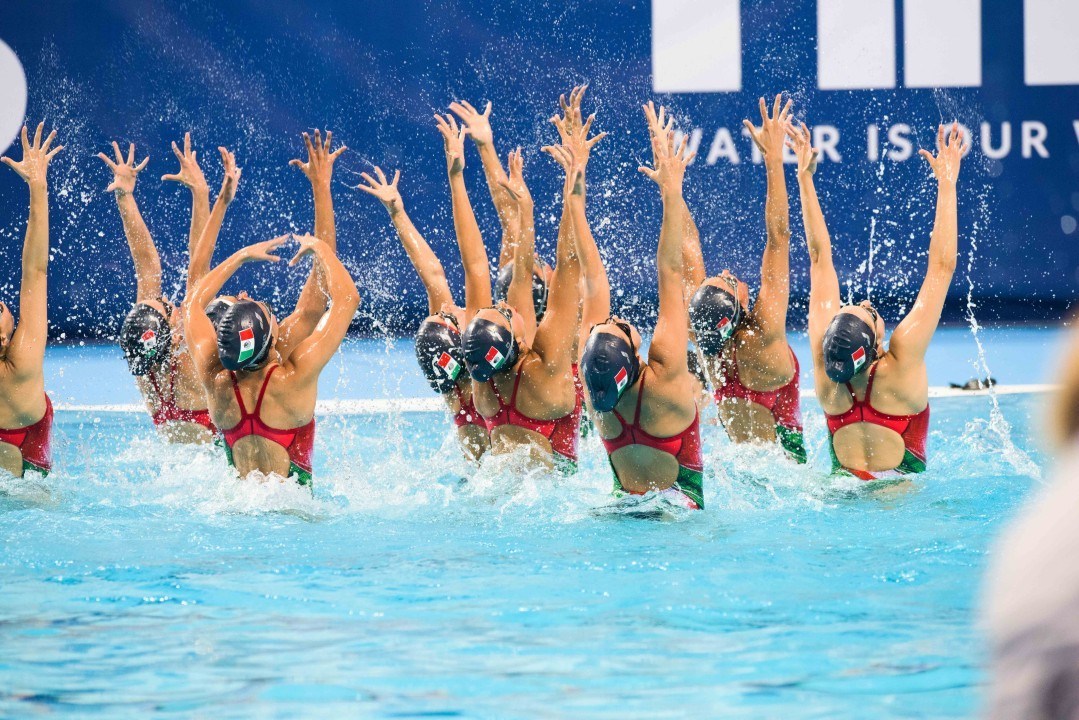Thanks to Dr. Andrew Friesen for contributing this piece.
Swimming is an emotional experience. Consider a two minute synchronized swimming routine: Within those brief 120 seconds, a swimmer might begin the routine with high confidence (“I’m going to have a strong performance!”), nail the beginning combination increasing excitement (“This is going to be a terrific performance that sends us to the Olympics!”), miss a crucial element in a pattern bringing up feelings of frustration (“That was a missed opportunity) and guilt (“I’ve let down my team and coaches”), arise from the water to give the judges a happy smile, (“Just smile!”), become anxious in anticipation for the final highlight (“If this doesn’t go well, we’ll miss qualifying”), and finally nail the final highlight increasing the swimmer’s pride (“I helped my team by giving the judges a lasting impression”). Seven different emotions within two minutes and each emotion will have the potential to help or hinder the swimmer’s performance.
With so many emotions being experienced, the ability to manage emotions in the heat of performance becomes an important skillset for every swimmer. Emotion regulation means the use of strategies to initiate, maintain, modify or display emotions1. This means that any attempt to change how long an emotion lasts, or how intensely you feel the emotion, or what you are actually feeling is an attempt at emotion regulation. Further, emotion regulation isn’t just about changing how you feel, but can also involve changing your behavior because of the emotion, and physiological responses (e.g., facial expression or breathing patterns).
The Emotion Regulation Tool Box
There are literally hundreds of different emotion regulation strategies. Some involve changing something in your environment; other involve changing your thoughts. James Gross2 has identified five families of emotion regulation. Each can be used in synchronized swimming:
• Situation Selection: A swimmer can modify their emotions by selecting which situation to engage in. For example, a swimmer who is nervous about re-aggravating an injury might choose to skip a practice in order to calm themselves. Goal-setting can act as a type of “situation selection” in that it can help ensure the swimmer remains in desired and intended situations.
• Situation Modification: Once dedicated to the situation, the swimmer can change some aspect of it to manage their emotions. For example, a coach might pair a young synchronized swimmer who has trouble with nerves with a veteran swimmer in a duet performance in hopes that the veteran’s swimmer’s calm demeanor and presence will calm the young swimmer as well and bring out the best performance. Consistently doing performance debriefs can help swimmers and coaches reflect on the reasons why a performance went well or not so well. This can lead to brainstorming potential options that are available for next time.
• Attentional Deployment: A swimmer can also choose what aspect of the situation to focus on (and/or ignore). For example, a swimmer who is feeling flustered with a teammate who just made a big mistake can choose to focus intently on her own remaining technical movements to keep herself engaged. Focus strategies that have primed the swimmer about what is in, and outside of, the swimmer’s control can be an effective tool here.
• Cognitive Change: A swimmer can choose what meaning or perspective to have about any situation. For example, a swimmer who is feeling sad because she performed poorly during a solo routine might remind herself that there is still an opportunity to go to the Olympics with a great team performance to cheer her up and focus her in the present moment. Given the strong link between how we perceive the situation around us and emotions, self-talk is an essential tool for effective cognitive change.
• Response Modulation (Suppression): After swimmers have experienced an emotion, they can try to alter the emotional response (behavioral, physical, or physiological). The most common example of this in synchronized swimming is seen when swimmers are expected to smile at the judges no matter what emotions they might be feeling. Having visualized potential responses to employ based on anticipated emotions can be an effective tool in this circumstance.
Each emotion has the potential to either help or hinder performance. Identifying which emotions does what in any given circumstance is the first step to learning how to manage emotions. Once this has been accomplished, synchronized swimmers can begin to identify and practice emotion regulation strategies that are both effective and are likely to be employed based on the swimmer’s ability and personality as well as the confines of the sport.
References:
1 Gross, J. J., & Thompson, R. A. (2007). Emotion regulation: Conceptual foundations. In J. J. Gross (Ed.), Handbook of emotion regulation (pp.3–24). New York, NY: Guilford Press.
2 Gross, J. J. (1998). Gross, J. J. (2015). Emotion regulation: Current status and future prospects. Psychological Inquiry, 26(1), 1-26.
Dr. Andrew Friesen is a sports scientist with a PhD in sports psychology. Originally from Winnipeg Canada, he has worked with provincial, national, amateur elite and professional athletes in Canada, USA and the United Kingdom. Andrew has a research expertise in emotions and emotion regulation in sport and is currently completing a postdoctoral fellowship at the University of Wolverhampton in England. You can follow him on Twitter: @apfriesen

